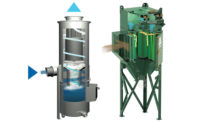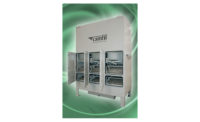After dust is collected
Safety monitoring filters give recirculated air a final scrub

Simply stated, these filters are designed for use when you want to recirculate air through the plant downstream of the collector. In reality, choosing and using safety monitoring filters is a bit more involved than that. Here are answers to the 10 most common questions.
1. What are the main components?
The key components are high efficiency ASHRAE-grade or HEPA filters that usually come pre-installed in housings for field installation. The number of filters needed depends on the size of the dust collector and airflow through the system. Filter efficiency will be determined by the size and characteristics of the dust particles being handled. Pre-filters, such as medium efficiency pleated air filters, are typically included to screen out larger dust particles, protecting the much more costly final filters and reducing their change-out frequency.
Ductwork and a transition section are usually required to connect this secondary filter module to the dust collection system. For some HEPA filter applications, integrated designs are available in which the safety filter is mounted on top of the collector so that no additional floor space is required.
2. When is a safety monitoring filter required?
It is a required component in recirculating dust collection systems that recycle air downstream of the collector when filtering hazardous or toxic dusts. Such systems should be equipped with HEPA filters rated to remove a minimum of 99.97 percent of airborne particles of 0.3 micron in diameter and larger.
3. Are there other situations in which these filters should be used?
Anytime air is being returned to the plant following the dust collection process, some type of safety monitoring filter is recommended. Today’s cartridge dust collectors offer high filtration efficiencies, and a properly designed and maintained cartridge collector will typically be able to satisfy OSHA requirements regarding Permissible Exposure Limits (PELs) for most dusts. Nevertheless, there is always the chance of a leak in the system. The safety monitoring filter provides backup protection in the event of a problem.
If the dust is non-toxic, ASHRAE-grade high efficiency filters can be used in place of more costly HEPA filters. The recommended ASHRAE filtration efficiency is 90-95 percent (MERV 14). For hazardous dusts, as noted, the extra protection afforded by HEPA filtration will be needed and safety monitoring filters will be a requirement, not an option.
4. When is it not appropriate to use safety monitoring filters?
Some applications involving thermal spray equipment, foundry furnaces or other emissions sources that have by-products of combustion can give off hazardous gases. While cartridge dust collectors can effectively capture the dry particulate contaminants from these processes, they cannot stop the hazardous gases; and the same is true of safety monitoring filters. In these cases, the air cannot be returned to the plant.
5. What if the system is handling an explosive dust?
When a safety monitoring filter is used on a collector handling an explosive dust, the complete system — i.e., the dust collector, ductwork and transition section, and safety monitoring filter module — should comply with NFPA standards for combustible dust handling. If you think your dust might be explosive, have it tested to determine the KST value of the dust, or how explosive it is.
Dust testing also helps with sizing explosion vents or suppression systems for the collector. Abort gates or an explosion suppression system between the collector and the separate housing for the safety filters may be required both to protect the safety filters and to stop a flame front from returning to the plant.
6. How does it contribute to improved air quality, safety and comfort?
Where hazardous dusts are present, the obvious and critical benefit is to provide failsafe protection against harmful dust exposure. But even with nuisance dusts, the safety monitoring filter plays an important role in protecting people and processes by ensuring that contaminated air won’t blow back into the facility. It provides a “belt and suspenders” approach to safety, as well as a final scrub of the air before it goes back into the plant. Workers stay more comfortable, equipment stays cleaner and housekeeping requirements are reduced.
7. What are the energy-saving benefits of using a recirculating system with a safety monitoring filter?
Air recirculation is, hands down, the single best way to maximize return on investment with a dust collector. By recirculating heated or cooled air back through the plant, the cost to replace that conditioned air is eliminated. Many plants report five- to six-figure annual energy savings as well as additional savings from earned utility rebates and incentives.
8. What other benefits can be expected?
Another advantage of recirculating systems is the reduction in regulatory paperwork. By containing the air indoors, you can deal with OSHA and avoid the time-consuming EPA permitting involved when contaminated air is exhausted outside. A new EPA regulation which states that contaminated air can no longer be exhausted outdoors in a large number of U.S. metalworking applications will further fuel this trend.
9. Can an existing dust collector be retrofitted with a safety monitoring filter?
Yes, an existing collector can be retrofitted with an ASHRAE or HEPA after-filter system to perform the backup function described above. It is not recommended, however, as a “fix” for dust collector problems. For example, if there is an ongoing issue with air leakage from the collector, or dissatisfaction with indoor air quality because the plant is equipped with an older collection system such as a low efficiency baghouse, a safety monitoring filter is not an appropriate solution. The filters will require frequent change-out, which can be prohibitively expensive; and the dust collector will still perform inefficiently and be subject to problems. In the long run, in these situations it is safer and more cost-effective to replace the old dust collector with a more reliable model.
10. What are the maintenance requirements?
Maintenance is straightforward. The unit should be equipped with a Magnehelic gauge to monitor pressure drop across the filters. When pressure drop reaches the prescribed limit, it is time to change
the filters.
Servicing the pre-filters is also important, because these components protect the more expensive filters behind them. Same as with the final filters, change-out can be based on pressure drop readings, though some facilities opt to replace the pre-filters on a scheduled maintenance basis.
Looking for a reprint of this article?
From high-res PDFs to custom plaques, order your copy today!







